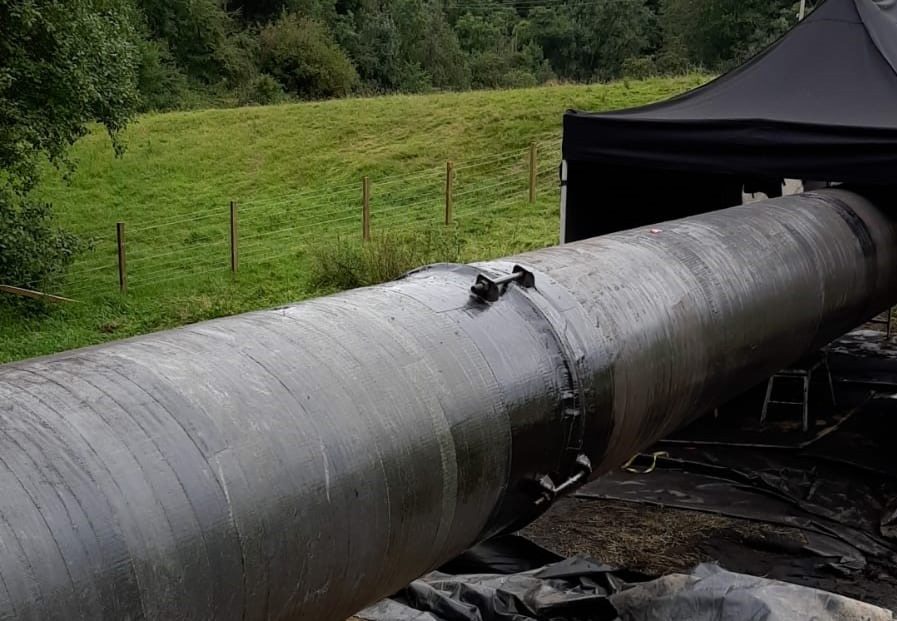Pipe Wrapping at Undershield Hill

Location: Undershield Hill, Carluke
Timeframe: August – October 2021
Key project features
Carbon wrapping
Grit blasting
Design
Resin injection
The background
Scottish Water required Mackenzie Construction to undertake works to repair and protect an overland pipe bridge near Undershield Hill Farm.
As this type of overland pipe is exposed to the elements, it often corrodes more than buried sections of pipework. Mackenzie Construction was asked to implement repairs and apply carbon wrapping to the pipe to protect it for the future.
In general, overland pipe sections would be bunded and overpumped to allow the section to be removed and replaced with a new pipe. However, this option wasn’t possible due to the inaccessibility of the relevant pipe intersections.
The initial challenge was the condition of the pipe, which initially looked in better condition than it really was. When grit blasting the surface of the pipe to create a smooth surface for wrapping, it became apparent that the pipe was more corroded than expected.
The challenge
The main challenge for this team was working on a live CSO pipe that was in poor condition. On re-assessing the level of corrosion on the pipe, the blasting process had to be modified to further protect the underside, particularly around the under barrels (which is often where significant wall thickness is lost due to corrosion), piers, and support rollers. Instead of grit blasting the entirety of the pipe, the team worked to hand clean the underside, whilst only grit blasting the top half to ensure the pipe remained intact.
As the project progressed onto implementation of the carbon wrap, Mackenzie Construction worked with pipe wrapping specialists, Belzona Technosol, as part of its supply chain. The process of carbon wrapping was undertaken to protect the pipe and reduce further corrosion. The process was identified as a method which would have several advantages over a full replacement, including: allowing the pipe to remain live, being less costly and disruptive with reduced damage to surrounding land as no access roads or type 1 bases were required. This solution also offers a reduced carbon footprint through elimination of requirements for imported materials or overpumping (and associated pumps on site) given the pipe was still live, and it also offers a reduction in the overall need for plant on site.
During the wrapping process, the team undertook localised repairs ahead of wrapping to ensure structural integrity and ideal surface area conditions for application.
In this phase of the project, it became clear that there was one section, around the support pier, which couldn’t be wrapped in the same way as the rest. When a pipe rests on rollers, it is a common issue that, due to wall thickness loss over time and the weight of the pipe itself, the pipe will often sink, fuse, and deform into the roller. In this case, the shape of the roller and the way the pipe had deformed around it, ensured that one section wasn’t able to be wrapped using the same process as the rest. The team had to then design a new solution for the issue.
The solution
After a period of design consideration and consultation, the Mackenzie Construction team built and shaped a box out of the carbon wrapping material. The box was measured to fit the exact current shape of the pipe under barrel, as well as encapsulate the roller support. Short sections of half barrel, prefabricated, carbon wrapping materials were moulded on site to fit the shape of the pipe under barrel. These were fitted under the pipe, held tightly to the roller on either side. The box section was then built around the roller to fit the pipe profile exactly. The team injected resin into the box, building it up in layers methodically, before wrapping the whole section of the pipe and sealing the area off to ensure it was secure.
Added value
Working together with our supply chain, Mackenzie Construction was able to work collaboratively to ensure it found an innovative, in-situ solution to a new challenge, whilst developing new skills and experience in carbon wrapping due to the successful work on this project.
